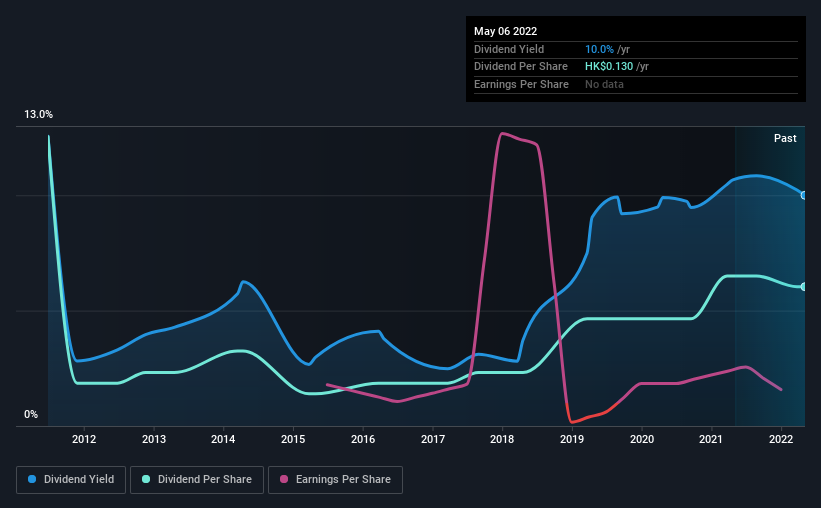Hung Hing Printing Group (HKG:450) Is Paying Out Less In Dividends Than Last Year
Hung Hing Printing Group Limited (HKG:450) has announced it will be reducing its dividend payable on the 21st of June to HK$0.09. However, the dividend yield of 10.0% is still a decent boost to shareholder returns.
See our latest analysis for Hung Hing Printing Group
Hung Hing Printing Group Is Paying Out More Than It Is Earning
If the payments aren't sustainable, a high yield for a few years won't matter that much. Before this announcement, Hung Hing Printing Group was paying out 139% of what it was earning, and not generating any free cash flows either. Paying out such a large dividend compared to earnings while also not generating free cash flows is a major warning sign for the sustainability of the dividend as these levels are certainly a bit high.
Earnings per share could rise by 6.8% over the next year if things go the same way as they have for the last few years. However, if the dividend continues growing along recent trends, it could start putting pressure on the balance sheet with the payout ratio reaching 236% over the next year.

Dividend Volatility
The company has a long dividend track record, but it doesn't look great with cuts in the past. The first annual payment during the last 10 years was HK$0.27 in 2012, and the most recent fiscal year payment was HK$0.13. This works out to be a decline of approximately 7.0% per year over that time. A company that decreases its dividend over time generally isn't what we are looking for.
Hung Hing Printing Group May Have Challenges Growing The Dividend
With a relatively unstable dividend, and a poor history of shrinking dividends, it's even more important to see if EPS is growing. It's encouraging to see Hung Hing Printing Group has been growing its earnings per share at 6.8% a year over the past five years. However, the payout ratio is very high, not leaving much room for growth of the dividend in the future.
The Dividend Could Prove To Be Unreliable
In summary, dividends being cut isn't ideal, however it can bring the payment into a more sustainable range. The track record isn't great, and the payments are a bit high to be considered sustainable. We would be a touch cautious of relying on this stock primarily for the dividend income.
It's important to note that companies having a consistent dividend policy will generate greater investor confidence than those having an erratic one. Meanwhile, despite the importance of dividend payments, they are not the only factors our readers should know when assessing a company. For example, we've identified 3 warning signs for Hung Hing Printing Group (2 are a bit concerning!) that you should be aware of before investing. Looking for more high-yielding dividend ideas? Try our collection of strong dividend payers.
Valuation is complex, but we're here to simplify it.
Discover if Hung Hing Printing Group might be undervalued or overvalued with our detailed analysis, featuring fair value estimates, potential risks, dividends, insider trades, and its financial condition.
Access Free AnalysisHave feedback on this article? Concerned about the content? Get in touch with us directly. Alternatively, email editorial-team (at) simplywallst.com.
This article by Simply Wall St is general in nature. We provide commentary based on historical data and analyst forecasts only using an unbiased methodology and our articles are not intended to be financial advice. It does not constitute a recommendation to buy or sell any stock, and does not take account of your objectives, or your financial situation. We aim to bring you long-term focused analysis driven by fundamental data. Note that our analysis may not factor in the latest price-sensitive company announcements or qualitative material. Simply Wall St has no position in any stocks mentioned.
About SEHK:450
Hung Hing Printing Group
An investment holding company, engages in book and package printing, consumer product packaging, corrugated box, and paper trading businesses in the People’s Republic of China, the United States, Hong Kong, the United Kingdom, and internationally.
Excellent balance sheet and good value.
Market Insights
Community Narratives



